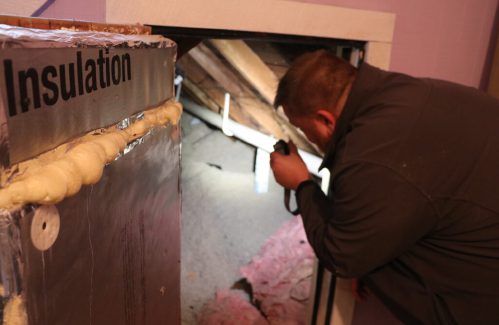
Editor’s Note: This story was first published on New Hampshire Bulletin.
The days are getting shorter, the temperatures are dropping, and energy costs are about to soar.
Some electric companies have already announced that their rates are going to rise as much as 60% this winter. And the cost for home heating fuels is swelling anywhere from 30% to over 50% or more, based on the kind of fuel and how cold the winter is.
New Hampshire’s congressional delegation has called on the Biden administration to use the strategic reserves as one way of lowering the costs (the administration last week announced the release of 50 million barrels from its oil reserve). The state Democratic Party held a news conference earlier this month blaming Gov. Chris Sununu for not doing more to lower energy prices, and Sununu in turn placed the blame on those in Washington.
Even as these policy debates are being waged, the professionals who are actually crawling around in New Hampshire’s attics and basements have long seen evidence that Granite Staters are taking these matters into their own hands when it comes to securing their homes against the cold temperatures.
Michael Turcotte, the owner of Turn Cycle Solutions in Nashua, said he’s found corn cobs and newspapers in the walls of New Hampshire’s old housing stock. At some point in the home’s long history, its owners had added that material as extra insulation.
That’s probably not what Ted Stiles, an energy auditor, would advise anyone to do as they look for ways to keep their homes warm and their bills down. When Stiles works on home audits, he’ll often see well-intentioned attempts to keep a home warmer.
But sometimes, those attempts aren’t doing anything at all.
Stiles, along with Andy Duncan, an energy training manager at Lakes Region Community College, have been working to teach people enough about home heating so they can avoid that outcome when making adjustments at home. Through a program called ButtonUp New Hampshire, the two put on a series of workshops across the state. Since the pandemic hit, they’ve been holding the sessions by Zoom.
“They’re designed for homeowners to learn about things they can do on their own — do it yourself to save on energy,” said Stiles.
In New Hampshire, about 40% of energy costs for a typical household go toward space heating, according to ButtonUp. For electricity, it’s usually an electric water heater that uses the most energy, followed by lighting, and then refrigerators and freezers. So these are areas that can be targeted for savings. In 2017, the typical New Hampshire household spent more than $3,000 on energy.
Saving money on energy bills at home can start with free or inexpensive measures.
For heating, this can include turning down the heat in an unoccupied room or in the entire house during the day when no one is home. Smart thermometers can set up a schedule for keeping the house at a particular temperature depending on the time or day of the week. The ButtonUp program also recommends removing window air-conditioning units to keep warm air inside and cold air out. Latching closed windows can help, too.
Jim McMahon, a resident of Londonderry, said his grandparents would go as far as closing off rooms in the winter, limiting the part of the house they had to keep warm.
Conserving energy — simply using less of it — is a way to save on electricity. This can be really straightforward, such as turning off something when it’s not in use. A smart power strip can help eliminate what’s called “phantom load,” when something is plugged in and using energy even while it’s not in use. A Samsung cable box is one example: It uses 28 watts of power when it’s on and recording, and 26 watts when it’s off and not recording.
For a small budget, residents can expect around a 50% return on their investment, according to numbers from ButtonUp. They recommend purchases like LED light bulbs, low-flow showerheads, and faucet aerators, as well as DIY air sealing in the attic and basement.
The biggest air leak areas follow the ABCs: the attic, basement, and center of the house.
“We start in the attic,” Turcotte said. “It’s like putting on that Russian wool hat in the middle of the winter. That’s the first line of defense you have on saving energy.”
“If you don’t put that nice hat on then you’re going to freeze your ass off, and same thing for the nice socks,” he said.
So, for homeowners, the message is to focus on the attic and basement first.
A larger budget makes other measures possible, including strategic air sealing, a smart thermostat, pipe insulation, duct sealing and window treatments. And ButtonUp estimates a 20% return on investment for this package.
Stiles cautioned that this price point is likely the time to get an expert involved.
“We talk about how to get an energy audit and why you might want to get one because once you start spending $1,000, you kind of want to make sure you’re doing it right,” he said.
A $10,000 budget pays for a complete energy assessment of a home, and would include upgrades to the attic, basement, and wall insulation, and installing things like a bath vent fan.
This also includes a test called the “blower door,” which is a staple of the industry. It’s a way of blowing air out of the house to see where cold air is entering, so those areas can be further insulated.
Typically, there’s a state program called NHSaves that offers rebates to help offset the cost of these programs. But this year, the program has run into some trouble since a new three-year plan that was designed to go into effect at the start of 2021 was rejected by the state.
So right now, residents should not look to the state when it comes time to foot the bill, according to Sarah Brock, the program director of climate, energy, and transportation for the nonprofit Vital Communities.
The rebates have changed over time, but most recently, Brock said, the cap for projects was set at $8,000, and 75% of the cost would be covered through the rebate.
But since the new three-year plan was rejected, residents aren’t getting those rebates any more, Brock said. She said the need still exists, with a lot of people in the state heating old homes with oil and propane.
“We can’t recommend that our neighbors go into this program because it’s in flux,” Brock said.




